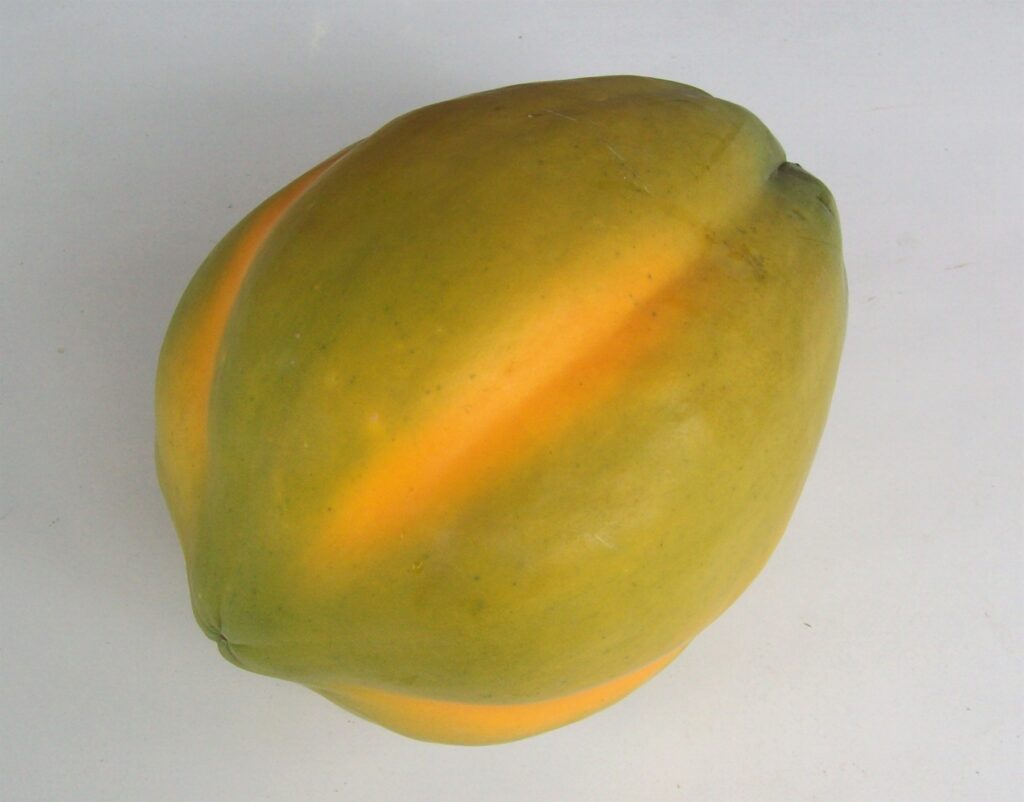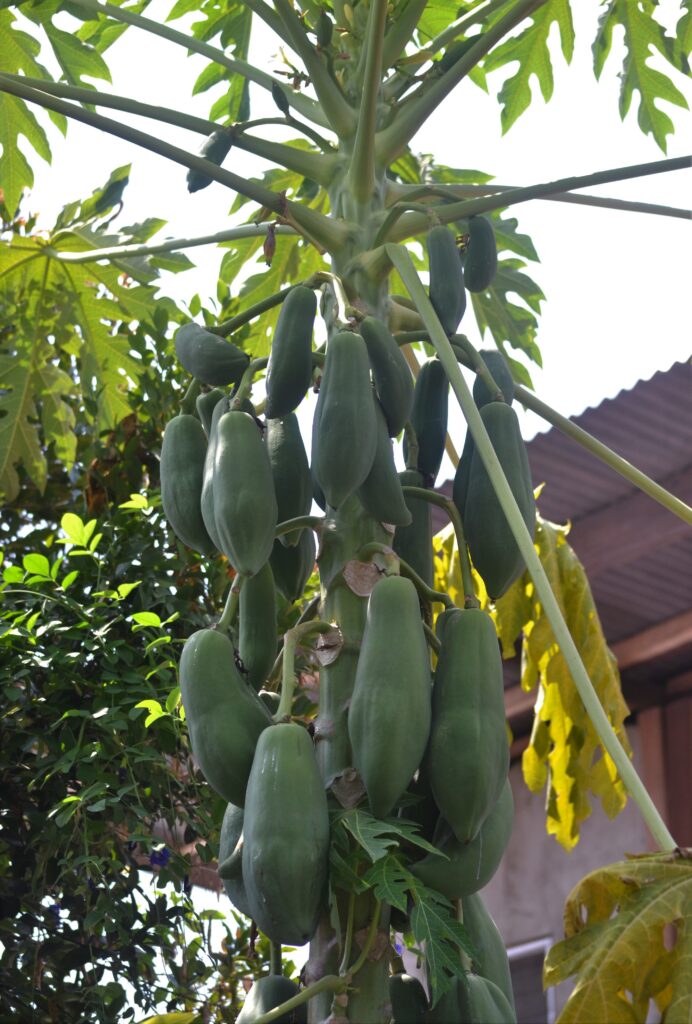PAPAYA: THE FRUIT THAT HEALS
Text and Photos by Henrylito D. Tacio
Papaya: The Fruit That Heals. Deliciously sweet with musky undertones and a soft, butter-like consistency, it is no wonder the papaya was reputably called the “fruit of the angels” by explorer Christopher Columbus.
In the Philippines, papaya is one of the favorite fruits that abound all year round. “It offers not only its luscious taste and golden yellow color but also its many health benefits,” says the Food and Nutrition Research Institute (FNRI), a line agency of the Department of Science and Technology.
“Low in calories and full of nutrition, papaya has more vitamin C than an orange,” says Amy Tousman, a registered dietitian based in Hawaii. “It’s loaded with vitamin A, potassium, folate and fiber. It also contains lutein and zeaxanthin, substances which help protect our eyes from age-related blindness.”
“A medium-size papaya supplies more than three times the adult recommended dietary allowance (RDA) of vitamin C, 75 percent of the RDA of vitamin A, and 800 milligrams of potassium,” writes J.C. Kurian, author of “Amazing Healing Plants.”

According to FNRI, the folic acid found in papaya helps in the conversion of a substance known as homocysteine. “The Medical Dictionary” defines homocysteine as “a naturally occurring amino acid found in blood plasma.” If left unconverted, it could do direct damage to blood vessels and if the levels of this substance increase, it could lead to heart attacks or strokes. It is also believed to increase the chance of Alzheimer’s disease and osteoporosis.
As an excellent source of three powerful vitamins – referring to C, A, and E – papaya helps prevent oxidation of cholesterol. “It is able to do this as it is associated with a compound known as paraoxonase, which is an enzyme that stops or reduces high-density lipoprotein (HDL) cholesterol oxidation and low-density lipoprotein (LDL) cholesterol,” the FNRI informs. HDL is considered the good cholesterol while LDL is known as the bad cholesterol as it carries cholesterol to cells and tissue.
According to the website of the World Healthiest Foods, the nutrients in papaya have been shown to be helpful in the prevention of colon
cancer. “Papaya’s fiber is able to bind to cancer-causing toxins in the colon and keep them away from the healthy colon cells. In addition, papaya’s folate, vitamin C, beta-carotene, and vitamin E have each been associated with a reduced risk of colon cancer,” the website claims.
Choosing to regularly eat lycopene-rich fruits, such as papaya, and drink green tea may greatly reduce a man’s risk of developing prostate cancer, suggests a research published in the “Asia Pacific Journal of Clinical Nutrition.”
In this case-control study involving 130 prostate cancer patients and 274 hospital controls, men drinking the most green tea were found to have an 86-percent reduced risk of prostate cancer compared to those drinking the least.
Enzymes like papain and chymopapain – which are both present in papaya – help in improving healing from burns and inflammation, people with asthma, rheumatoid arthritis and osteoarthritis can benefit from the nutrient of this fruit.
While one study suggests that high doses of supplemental vitamin C makes osteoarthritis, a type of degenerative arthritis that occurs with aging, worse in laboratory animals, another indicates that vitamin C-rich foods, such as papaya, provide humans with protection against inflammatory polyarthritis, a form of rheumatoid arthritis involving two or more joints.
Papain is also popular as a topical application in the treatment of cuts, rashes, stings and burns. Papain ointment is commonly made from fermented papaya flesh, and is applied as a gel-like paste. Perhaps not too many have known that Hollywood actor Harrison Ford was treated for a ruptured disc incurred during filming of “Indiana Jones and the Temple of Doom” by having papain injected into his back.
Papaya is also good for eyesight. “The carotene pigment found in papaya gets converted to vitamin A when consumed and promotes good eyesight,” FNRI says.
For those losing vision, they should eat more papaya. Data reported in a study published in the “Archives of Ophthalmology” indicates that eating three or more servings of fruit per day may lower your risk of age-related macular degeneration, the primary cause of vision loss in older adults, by 36%, compared to persons who consume less than 1.5 servings of fruit daily.

“Three servings of fruit may sound like a lot to eat each day, but papaya can help you reach this goal,” the website of the World Healthiest Foods states. “Add slices of fresh papaya to your morning cereal, lunch time yogurt or green salads. Cut a papaya in half and fill with cottage cheese, crab, shrimp, or tuna salad. For an elegant meal, place slices of fresh papaya over any broiled fish.”
Papaya has recently also been known to help smokers or passive smokers as cigarette smoke contains a common carcinogen which brings on vitamin A deficiency. Being rich in vitamin A, this fruit helps in countering the negative effect.
To those who want to lose weight, papaya is recommended as the fruit is very low in calories, cholesterol free and fat free. Some researchers also believe that the enzyme papain helps in increasing metabolism and breaks down protein. Dieticians often advise the papaya in their weight-loss diet programs.
Since the fruit is packed with vitamins, potassium, thiamine, riboflavin, niacin, calcium and iron, it makes for a great energy boosting source. A refreshing papaya juice might just be the thing to prepare you for a long hard day’s work.
The milk-like juice from unripe papaya fruit, called latex, is widely used to remove warts, freckles, and other blemishes. Researchers discovered that the latex is a chief source of papain, a protease which is useful in tenderizing meat and other proteins. Crushed leaves wrapped around tough meat will tenderize it overnight.
“Because of its papain content,” wrote Julia F. Morton in her book, Fruits of Warm Climates, “a piece of green papaya can be rubbed on a portion of tough meat to tenderize it. Sometimes a chunk of green papaya is cooked with meat for the same purpose.”
Papain has many other practical applications. It is used to clarify beer, also to treat wool and silk before dyeing, to de-hair hides before tanning, and it serves as an adjunct in rubber manufacturing. It is reportedly applied on tuna liver before extraction of the oil which is thereby made richer in vitamins A and D. Papain is also part of the preparation of some toothpastes, cosmetics and detergents.
But here’s a hitch: “There can be risks in ingesting papain,” warns Tousman. “Papain supplements and green papayas may increase the risk of miscarriage. Pregnant women should only use them under medical supervision.” Seeds, too, may bring on abortion. But ripe papaya is safe to eat during pregnancy.
Speaking of papaya seeds, Atty. Nelly Favis Villafuerte wrote in her column in a national daily that the black seeds are “edible and are used not only to expel worms but also used in the treatment of cirrhosis of the liver due to different causes like alcoholism and malnutrition.”
She further wrote: “Not many know that a tablespoon of juice extracted by grinding the seeds and mixing it with 10 drops of fresh lime juice taken once or twice daily for a month is already being used as a treatment of a patient suffering from cirrhosis. As an antihelmintic (drugs that expel parasitic worms from the body), the papaya seeds are chewed and swallowed (2 teaspoon of seeds) after each of the 3 principal meals.”
In some parts of the world, green fruits are harvested as vegetables. Some studies have shown that unripe papaya fruits are toxic and so they must be cooked before eaten. Raw green papaya is frequently used in Thai and Vietnamese cooking. In the Philippines, it is a common ingredient in chicken “tinola.” Even for use in salads, it must first be peeled, seeded, and boiled until tender, then chilled.
Aside from fruits, other parts of papaya can also be eaten. In the East Indies, young leaves are also eaten like spinach but they are cooked first. Studies have shown that papaya leaves contain the bitter alkaloids (carpaine and pseudocarpaine), which act on the heart and respiration like digitalis, but are destroyed by heat.
In the Philippines, bruised papaya leaves are used as a poultice in treating rheumatism, according to the Department of Agriculture. “In nervous pains, leaves can be dipped in hot water or warmed over a fire and applied,” the government agency informs. “As purgative, one tablespoon of the fresh fruit juice mixed with honey and 3 to 4 tablespoons of boiling water is taken one draught by an adult; two hours later, it is followed by a dose of castor oil. This treatment is repeated for 2 days, if necessary, for children aged 7 to 10 years old. For children under 3 years, half the dose is given.”

